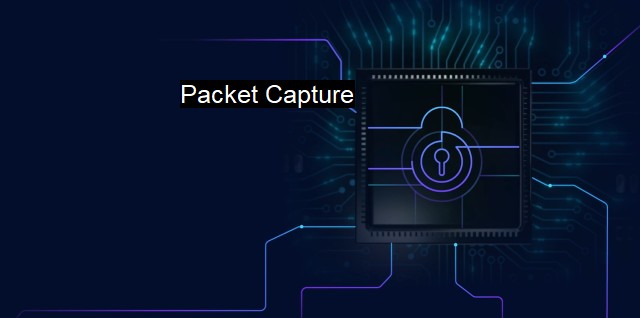What is Packet Capture?
Utilizing Packet Capture for Proactive Cybersecurity Management and Analysis: An Overview of Techniques for Intercepting and Recording Network Traffic Data for Threat Detection
Packet capture refers to the act of intercepting and logging traffic flowing over a digital network. It is a crucial technique used in network security for monitoring, troubleshooting, and analysis. Often the term 'packet sniffer' or 'protocol analyzer' is used interchangeably with packet capture. Precisely, this technique involves capturing 'packets' of data that are transmitted over a network. These packets are fundamental to network communications - they house the exact data and metadata about the source, destination, transmission protocol, and more. A packet may be an email, web page, or data from any other application that is sent from one device or server to another over the internet.Packet capture allows network administrators to deeply inspect the network's communication patterns and usage. They use packet capture tools such as tcpdump, Wireshark, and many others to record incoming and outgoing packets. These packets are then used to analyze, debug, and optimize network performance. It also has the potential to spot a variety of security threats. For instance, by inspecting abnormal traffic patterns, administrators can identify potential cyberattacks, including Distributed Denial of Service (DDoS) attacks, covert botnet activities, or attempted intrusions.
Relating packet capture within the context of an antivirus can be very significant. Antivirus software incorporates various security techniques, including packet capturing, to monitor network traffic and identify potential malicious activity by comparing every packet of data it captures against a database of known threats. When a packet matches a signature in the database, the antivirus software can thence block or quarantine the associated action, preventing malware, intrusion, or virus from infecting the system.
Packet capture even plays a vital role in forensic analysis after a cyberattack has taken place. Captured packets can be used to reverse-engineer an attack, especially when working with advanced persistent threats. The detailed packet logs can offer a trail of breadcrumbs to follow back to the attacker, the tactics, techniques, and procedures deployed, the targeted system or data areas, any vulnerable unpatched systems, and more.
Despite its many merits, using packet capture for monitoring also poses some risks. It could be considered as an invasion of privacy, and there are growing concerns regarding the use of packet sniffing by malicious actors. Unauthorized use of packet capture tools can breach confidentiality protocols and privacy norms by eavesdropping and intercepting sensitive information like credentials or financial data. Also, collecting, storing, and processing vast amounts of data is not just resource-intensive, but it can also add the risk of creating a data management bottleneck.
In order to address these issues, there tends to be a set of best practices followed by network administrators with packet capture. One of the examples is using encryption for sensitive data which provides an additional layer of protection against cyberattacks. Only trusted individuals with necessary clearances are given access to use packet capture tools. All legal and regulatory frameworks range from General Data Protection Regulation (GDPR) to the Health Insurance Portability and Accountability Act (HIPAA) are strictly complied with in the utilization of packet capture technologies.
Packet capture is an indispensable tool in any cybersecurity stalwart's arsenal. When combined with complementary security measures and good traffic hygiene, it acts as a potent cornerstone to securing network infrastructure. Amidst growing digital threats, businesses and individuals should stay informed about the significance of packet capture as it aids in maintaining the balance in the ever-evolving complex cyberspace scenario.

Packet Capture FAQs
What is packet capture and how is it used in cybersecurity?
Packet capture is the process of intercepting and logging network traffic. In cybersecurity, packet capture is used to analyze network traffic for security purposes, such as detecting and preventing malware, viruses, or other cyber attacks. It can also be used to troubleshoot network issues and optimize network performance.What types of data can be captured with packet capture?
Packet capture can capture various types of data, including network protocols, IP addresses, domain names, URLs, login credentials, and other sensitive information that is sent over a network. This information can be used by cybersecurity professionals to identify potential security threats and prevent cyber attacks.What tools are used for packet capture in antivirus software?
Packet capture tools used in antivirus software include Wireshark, Snort, and tcpdump. These tools can capture and analyze network traffic in real-time and generate reports that provide insights into potential security threats. They can also be used to identify and block malicious traffic and prevent cyber attacks.Is packet capture legal?
Packet capture is legal if it is done for legitimate purposes, such as network troubleshooting, monitoring network traffic for security purposes, or analyzing network traffic for optimization. However, it is illegal to capture and intercept data without the user's consent or for malicious purposes. It is important to follow local laws and regulations regarding packet capture to ensure compliance and protect user privacy.| | A | | | B | | | C | | | D | | | E | | | F | | | G | | | H | | | I | | | J | | | K | | | L | | | M | |
| | N | | | O | | | P | | | Q | | | R | | | S | | | T | | | U | | | V | | | W | | | X | | | Y | | | Z | |
| | 1 | | | 2 | | | 3 | | | 4 | | | 7 | | | 8 | | |||||||